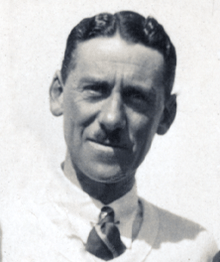Valentine Vivian
| Valentine Patrick Terrel Vivian | |
|---|---|
 Colonel Valentine Vivian | |
| Nickname(s) | Vee-Vee (as head of Section V) |
| Born |
17 March 1886 Kensington, England |
| Died |
15 April 1969 (aged 83) Lymington, England |
| Allegiance |
|
| Service/branch |
|
| Rank | Colonel |
| Battles/wars |
|
| Awards |
|
| Other work |
Asst Superintendent of Police (Punjab) 1906 Superintendent of Police (Punjab) 1907 Asst Director Central Intelligence (India) 1914 |
Colonel Valentine Patrick Terrell Vivian CMG CBE (1886–1969) was the vice-chief of the SIS or MI6 and was the first head of its counter-espionage unit, Section V. It was Vivian, who while attempting to introduce new blood into the service, selected Kim Philby who was later to become notorious as "The Third Man" double agent and who defected to the Russians causing considerable harm to the system he had infiltrated.[5]
Family background
Valentine Vivian was born on 17 March 1886 in Kensington, London. He was the youngest of nine children of Tom Comely, portrait painter, and Elizabeth Baly Farquhar, miniature painter. His brother Sir Sylvanus Percival Vivian (1880–1958) was former Registrar General of England from 1921 to 1945.[6]
In 1911, Vivian married Mary Primrose Warlow, daughter of the Venerable Edmund John Warlow, archdeacon of Lahore, India.
Early career
Vivian joined the Indian Police (Imperial Service) in December 1906 and was posted as assistant district superintendent of police for Punjab, reaching the rank of assistant superintendent in November 1907, and subsequently superintendent of police for Ambala, Ludhiana, Jhang, Hissar, Sialkot, and Lahore railway police. He was senior superintendent of police for the Delhi province and in October 1914 became an assistant director of central intelligence (Simla). He retired from the Indian Police in 1925.[7][8]
In the mid-1920s, agency director Sir Hugh Sinclair, the second "C", wanted to absorb MI5, the UK's counter-intelligence agency, into the SIS; when his attempt was finally rejected, in 1925, he formed the CE section, later (1939) renamed "Section V".
Between 1925 and 1931, organisational rivalries proliferated among Vivian's CE section, the domestic intelligence agency, MI5, and Scotland Yard. A network of domestic agents known as the 'Casuals' had provided information to CE section. In 1930, after a series of meetings of the Special Services Committee, the Casuals were transferred to MI5, where they became "M Section"; many still provided the SIS with information.
Under Vivian, Section V focused on the activities of the Comintern, which Vivian initially "regarded ... as a criminal conspiracy rather than a clandestine political movement". Vivian was the author of the 1932 report (FO 1093/92) on the Hilaire Noulens case, though his authorship was only revealed in 1994.
During the First World War Vivian served in the Indian Army in Turkey and Palestine. At one point early in his career, he served in the Department of Criminal Intelligence (Simla) in India.
References
- See, in particular, "The Secret Service Committee, 1919-1931", Gill Bennett, Chief Historian, Foreign & Commonwealth Office; and "The Secret Intelligence Service and the Case of Hilaire Noulens", Christopher Baxter, Historian, Foreign & Commonwealth Office.
- ↑ The London Gazette: (Supplement) no. 37909. p. 6. 1 January 1947. Retrieved 31 July 2010.
- ↑ The London Gazette: (Supplement) no. 37909. p. 1312. 20 March 1947. Retrieved 31 July 2010.
- ↑ India Office List 1933. Searchable via FindMyPast at http://www.findmypast.co.uk/ accessed: 31 July 2010
- ↑ The London Gazette: (Supplement) no. 30730. p. 6716. 4 June 1918. Retrieved 31 July 2010.
- ↑ The Times Obituaries 1961–1970
- ↑ Who Was Who 1951–1960 p. 1121
- ↑ India Office, Record of Services, p. 892, 1933
- ↑ Who's Who 1934
External links
- Discusses SIS director Sir Stewart Menzies's reorganisation of units into "Headquarters" and "Foreign" divisions, including Section V